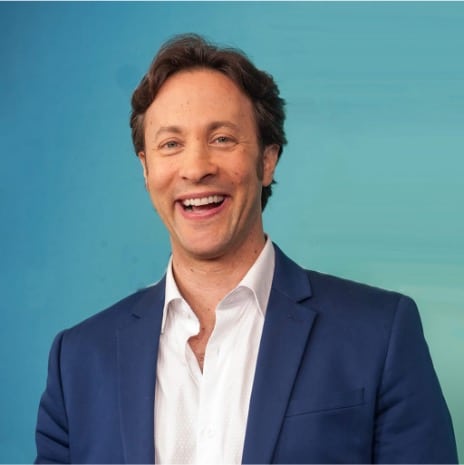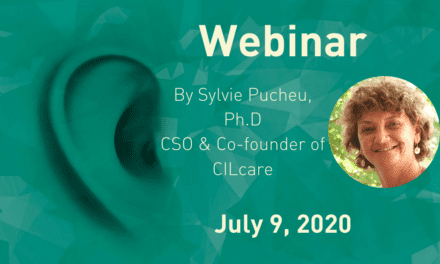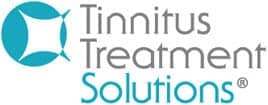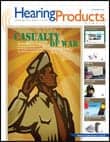How can you hear more clearly by wearing a wristband? Neosensory’s award-winning wristband is designed to put decades of neuroscience research into a wearable that delivers innovative hearing healthcare solutions for tinnitus and hearing loss. Created by Stanford neuroscientist David Eagleman, PhD, the Neosensory wristband uses an onboard microphone to listen to the environment and deliver information to the brain using patterns of haptic vibrations on the skin.
The Hearing Review’s chief editor, Melanie Hamilton-Basich, sat down with Dr Eagleman to discuss how Neosensory solutions are helping audiology patients across the globe, including for tinnitus treatment. Dr Eagleman’s research is published in the top journals in the field, including Science and Nature. He is an internationally bestselling author about the brain, with his books translated into 33 languages, and is the creator and host of PBS’s Emmy-nominated series “The Brain with David Eagleman.” He also hosts the number one science podcast on Apple Podcasts, “Inner Cosmos.”
What was the inspiration for the Neosensory wristband, and how did it evolve into the current product that uses haptic vibrations to allow users to “listen with their skin”?
I’ve always been fascinated that the brain constructs all the sights and sounds around you, and yet it is locked in silence and darkness inside the skull. All the brain ever sees are patterns of electrical and chemical signals, and from those it constructs its entire colorful reality. So I got very interested in the question of whether we could push information to the brain via unusual channels—in this case, using patterns of vibration on the skin.
My student and I built a vest that captures sound and turns it into a spatial pattern of vibrations on the skin, and we demonstrated that people with severe or profound hearing loss could come to understand the world this way. I presented these findings at a TED talk some years ago and then we spun this technology out of the lab as a company, Neosensory. With time we shrunk the technology down to a wristband, and now it’s on wrists all over the world. People capture auditory signals through their skin, and with practice the brain figures out how to interpret them.

Your three Neosensory products all use the wristband, but they all provide different benefits. What makes each solution different?
Let’s start with Sound Awareness. This solution is used primarily with members of the Deaf community or individuals with hearing devices or cochlear implants. The wristband has an onboard microphone and several vibrating motors, and in Sound Awareness mode it captures the sounds in a person’s environment and analyzes their frequency amplitudes. The band translates those pitches into different vibrations on the wrist, allowing patients to differentiate between sounds in their environment.
For example, Amazon has a high number of Deaf employees working in their warehouses who need increased situational awareness around heavy machinery like forklifts or trucks. Sound Awareness gives them access to those sounds and increases workplace safety. It’s also been a great accessory for patients who use high-gain hearing aids or cochlear implants. Traditionally, when they take their devices off at night, they sacrifice situational awareness, posing safety concerns in the event of emergencies. With Sound Awareness, these patients wear the wristband at night and put it into “sleeping mode,” which will alert them to any loud noises in their surroundings.
Can you talk about Neosensory’s solution for tinnitus that also uses the wristband?
Yes. Building upon the technology already in the wristband, we created Duo, our solution for tinnitus. Duo uses bimodal stimulation—that is, stimulating the touch and hearing senses simultaneously—by playing targeted sounds in conjunction with haptic feedback from the wristband. After downloading our app, the user is asked to match the pitch and volume of their tinnitus to ensure the algorithm plays tones that are centered around the patient’s primary tinnitus frequency. Once matched, the patient begins their first 10-minute session by listening to the tones while feeling the matching vibrations. During these sessions, the brain learns which tones are produced externally (those are “verified” by vibrations on the wrist) and which sounds are purely internal—that is, the tinnitus, which never receives “confirmation” on the wrist. When patients stick to the protocol of 10 minutes per day for eight weeks, 9 out of 10 report a significant decrease in the perception of their tinnitus.
What is the third solution Neosensory provides using its wristband?
Our third solution is Clarify, which is a treatment for high-frequency hearing loss. Like Sound Awareness, Clarify uses the wristband’s onboard microphone to listen to sounds in the environment—but here it listens only for speech sounds. The algorithm listens just for four target phonemes (/s/, /t/, /z/, and /k/), activating a corresponding vibrational pattern on the wristband for each sound.
The four phonemes were chosen based on how difficult each phoneme is for users with hearing loss to hear, how frequently each phoneme occurs in spoken English, and how well our algorithm can detect each phoneme. The phoneme difficulty was pooled from several prior research studies of phoneme confusion for those with hearing loss. Our studies show that users experience improvement in speech understanding when using Clarify mode, either as a stand-alone device, or in conjunction with hearing aids. In fact, our studies show that pairing Clarify with hearing aids can unlock over 25% additional benefit from hearing aids when they are used together.
Can you share more about what makes your approach to treating tinnitus with Duo unique?
Duo is an evidence-based tinnitus solution in a wearable device that only takes 10 minutes a day to provide relief in eight weeks. And we find positive results for 9 out of 10 users. There currently is no other device on the market that leverages bimodal stimulation in this format and also has these outcomes in such a short timeframe.
With so many veterans in need of care for tinnitus, are you working on getting Duo into the VA?
We’re working on that. Tinnitus is the number one VA disability claim for military veterans. Given this, we see a bright future for Duo in the VA. Today, we’re registered through the System for Award Management (SAM.gov), meaning we are available in the VA via off-contract ordering. So the door is now open for us to bid on government contracts and pursue a more formal relationship.
That said, hundreds of veterans have opted to pursue the wristband directly through our e-commerce site and have been quite vocal online about their success. Veteran interest hasn’t been limited to Duo, either. We’ve had several veterans who use Clarify to address their hearing loss and have experienced benefits so significant they became official ambassadors. In one veteran’s words, “Until you perceive that range of hearing, you won’t understand: It’s the difference between seeing in black and white and color.”
Is there a specific age group that can benefit from Neosensory products? How might various patient populations’ needs differ?
The wristband can help patients across the age spectrum, from children to adults. Currently, our published research focuses on treatment in adults across the age spectrum and we’ve found our solutions work equally well for all patients over the age of 18. For Duo, our most successful patients are those who have bothersome tinnitus, scoring above a 25 on the Tinnitus Functional Index (TFI). For Clarify, though, several different use cases show promising results. We found that patients without hearing aids saw an 18-point increase on the APHAB using the wristband alone, but interestingly, patients who already wore hearing aids also saw an increase in their APHAB scores, averaging an additional 25% improvement on top of what they already received with hearing aids alone. As a result, providers have begun using Clarify as a default accessory for patients who have poor word recognition scores to provide clarity where their hearing aids fall short.
We recently expanded our research to include children, including ongoing projects looking at the use of Clarify in the Classroom, Clarify with auditory processing disorder (APD), Clarify with cochlear implants, and Sound Awareness with Deaf students. While we are still collecting data, the preliminary data shows positive use cases in each of these four scenarios and we are looking forward to analyzing the final results.
What role do you see hearing care professionals playing in connecting patients with Neosensory products?
After several years working with end-users directly, one thing has become very clear: hearing healthcare professionals (HCPs) play an essential role in a patient’s Neosensory journey. While some patients are comfortable purchasing the band online, many have voiced a desire to speak with an HCP before pursuing treatment. Given this, we’ve seen providers incorporate Neosensory into their practice. This has played out in several different ways. Most often, providers opt to sell the band to patients in the clinic as part of the overall hearing health treatment plan. Because consultations for tinnitus patients are notoriously low-revenue-generating appointments, most providers like to dispense the device in their clinics, both to keep the patient in-house and to generate additional revenue for their practices. On the flip side, we’ve also seen providers sell the device using an OTC model or even simply directing patients to our e-commerce site.
What about cost and reimbursement for Neosensory devices?
For patients who opt to pursue Neosensory solutions through our e-commerce platform, the cost for all three solutions is $999. For Duo specifically, we offer a rental program where patients can pay $250/month with the option of returning the wristband after they have completed their two-month treatment cycle. That said, because the wristband has become a source of significant comfort, an overwhelming majority of patients opt to keep the wristband.
For providers offering our solutions in their practices, our team works closely with partners to set up wholesale pricing that allows them to maintain our e-commerce pricing with patients while maintaining profitability for their clinics. We are also building relationships with a number of insurers and Health Service Account (HSA) providers. We recently submitted for HSA approval and we expect to be HSA reimbursable in early 2024, increasing accessibility for patients across the U.S.
What if providers want to use both Clarify and Duo for their patients–do they need to purchase separate devices?
No: Our wristband is a 3-in-one device. Anytime a provider orders a Neosensory wristband, the patient has access to all three solutions and can easily switch between the modes via our free Neosensory app.
Speaking of providers, can you share the details of Neosensory’s new partnership with AuDConnex?
We’re excited to be launching our partnership with AuDConnex now. With their reputation as champions for the audiology community, AuDConnex shares our vision to prioritize comprehensive, evidence-based patient care while encouraging healthy practice growth for providers. Prior to our partnership, we initiated a pilot with patients at AuDConnex clinics that had overwhelmingly positive results in only four weeks. It was incredible to see and share patient success with AuDConnex and help providers gain comfort and confidence in our solutions for their patients.
As part of the launch, we are offering several CEU courses aimed at increasing provider comfort with our solutions, focusing specifically on supporting research, target patient populations, and guidelines for clinical implementation. We also offer CEU courses for providers wanting to learn more about our solutions, so I’d encourage providers interested in Neosensory to reach out to our team to learn more.
Sponsored By






